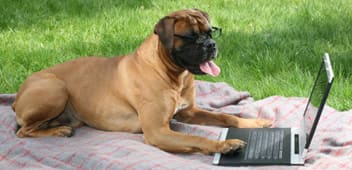Rocky’s Viewpoint

We all know the saying “use it or lose it”. This saying not only applies to us, but also our dogs. We all need to exercise regularly. Our dogs need regular, moderate and healthy exercise. The proper level of exercise depends on a number of factors, including age, weight, physical condition, and more.
Healthy exercise engages the mind as well as the body. When you engage the mind, it adds meaning and interest to the exercise. When you combine the two the risk of injury is reduced. The type of exercise you give your dog and its duration depends on the fitness level of your dog. For some, mental and physical warm-ups alone may be enough.
You want to give special consideration to puppies, old dogs and those with various illnesses and injuries. Also, some breeds may not be suited for hard work, for example short snouted breeds like Pugs and Pekingese. However, that’s not to imply that they shouldn’t workout, you just may give them a lighter workout.
Old Dogs: Just because your dog is old, doesn’t mean he shouldn’t exercise. His/her activities just need to slow down, not stop. Perhaps a slower, shorter walk is order, or a swim session. As long as your dog can participate safely he’ll be happy and healthy a lot longer.
Disabled Dogs: A middle course is best with these dogs. Activities that stimulate the mind, fulfill the emotions, and exercise the body in ways that don’t add stress to your dog’s life, like scent tasks, are ideal. These exercises burn lots of calories without running or jumping.
Working Dogs: Exercises for these dogs come through work. Focusing power into the work is the best way to give these dogs quality exercise. But because of the nature of these dogs, it’s up to you to make sure he is not overworked. On the flip side, teach your dog the quiet pleasures, such as low-impact scent and obstacle tasks, or just settling down by your side.
Obsessive Dogs: Sometimes exercise can turn into another obsession. Teach your dog a wide range of activities, then vary them. That will help him to develop a more flexible mind. Depending on your dog’s physical condition, activities might include, tracking, searching for food you’ve hidden, working an obstacle course, retrieving games, or doing household chores.
Lazy/Lethargic Dogs: If your dog is healthy, it may be he is just an easy-going dog. Mild exercise works well for a dog who leads a mild life. He’s your companion so you will want to provide interesting activities for him such as a walk, playing fetch or other games.
Overly Confined Dogs: This type of dog is probably spending a lot of time in a crate. When released most likely your dog will expend a huge amount of energy at once, increasing the risk of injury. Moderate exercise such as brisk walks over a longer duration is kinder to this dog’s body and is also mentally healthier.
Busy Owner: For all dogs and you, appropriate exercise in partnership with your dog is most fulfilling and helps to keep both of you emotionally and physically healthy. Take the time and spend it with your “best friend”.